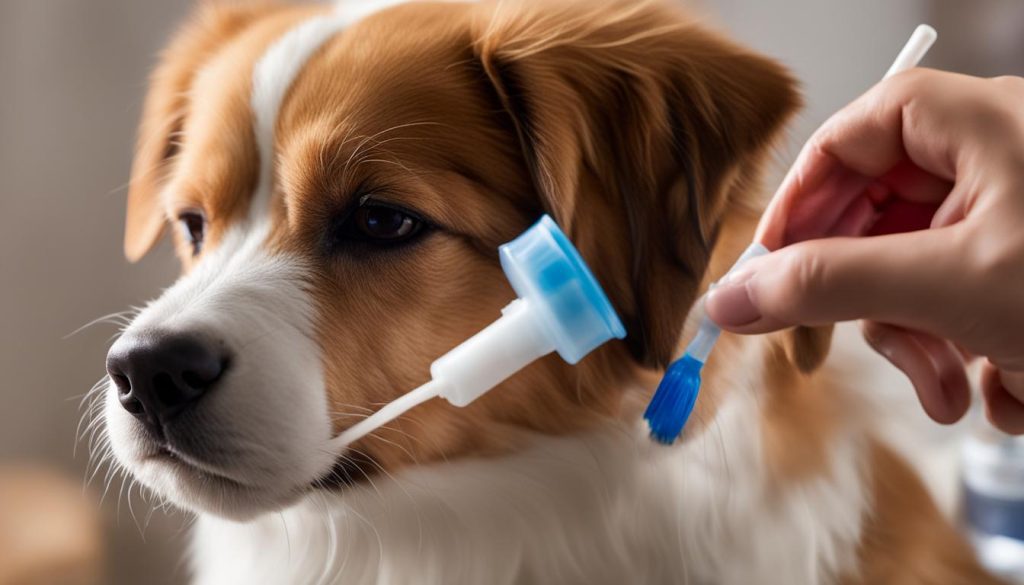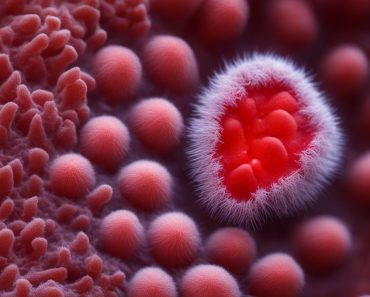Greetings! In today’s article, I’ll be diving into the topic of dog ear infections. As a pet owner, it’s essential to be aware of the symptoms, treatment options, and preventive measures to ensure the well-being of your canine companion.
Ear infections, also known as otitis, are a common problem in dogs. They can occur due to bacterial or yeast infections, or sometimes a combination of both. If left untreated, dog ear infections can lead to more serious complications such as hematoma, ruptured eardrums, and even hearing loss.
The signs of a dog ear infection are noticeable and can include head shaking, scratching at the ears, dark discharge, odor, redness, and swelling of the ear canal. These symptoms can be painful and uncomfortable for your furry friend.
Now, let’s explore the various treatment options available for dog ear infections. Depending on the severity of the infection, your veterinarian may prescribe topical or oral medications to combat the infection-causing bacteria or yeast. In some cases, ear cleaning may also be necessary to remove debris and facilitate the effectiveness of the medications. Severe or chronic ear infections may require surgery as a last resort.
Prevention is always better than cure, and dog ear infections are no exception. Regular ear cleaning with vet-approved products can help prevent infections. Thoroughly drying your dog’s ears after bathing or swimming is also crucial in preventing moisture buildup, which can contribute to ear infections. Additionally, identifying and managing underlying conditions, such as allergies or endocrine disorders, can further decrease the risk of ear infections in dogs.
Key Takeaways:
- Pay attention to the signs of a dog ear infection, including head shaking, scratching, discharge, redness, and swelling.
- Consult a veterinarian for proper diagnosis and tailored treatment options.
- Treatment may involve topical or oral medications, ear cleaning, or surgery in severe cases.
- Preventive measures like regular ear cleaning and thorough drying can help reduce the risk of ear infections.
- Identify and manage underlying conditions to further prevent dog ear infections.
Causes and Risk Factors of Dog Ear Infections
Several factors can contribute to the development of ear infections in dogs. Understanding these causes and risk factors can help you take proactive measures to prevent ear infections and keep your furry friend healthy and happy.
Moisture and Ear Infections in Dogs
Moisture is a common culprit when it comes to dog ear infections. Excessive moisture in the ear creates the perfect breeding ground for bacteria and yeast. This can happen when a dog goes swimming or after a bath, especially if water remains trapped in the ear canal.
Allergies and Ear Infections in Dogs
Dogs with allergies, such as allergic skin disease or food sensitivities, are more susceptible to ear infections. The constant itching and scratching resulting from allergies can irritate the ears and disrupt the natural protective barriers, making them more vulnerable to infections.
Endocrine Disorders and Ear Infections in Dogs
Endocrine disorders, like thyroid disease, can also increase the risk of ear infections in dogs. These disorders can affect the immune system and the production of ear wax, creating an environment where infections are more likely to occur.
Wax Buildup and Ear Infections in Dogs
Excessive wax buildup in a dog’s ear can contribute to ear infections. Wax provides a protective barrier against infection-causing organisms, but when there is an abnormal accumulation, it can block the ear canal, trap moisture, and create an ideal environment for bacteria and yeast to flourish.
Injury to the Ear Canal and Ear Infections in Dogs
Injury to the ear canal, such as from scratching or aggressive cleaning, can lead to ear infections. When the delicate skin of the ear canal is damaged, it becomes more susceptible to infections. It’s important to handle your dog’s ears with care and avoid any activities that could cause harm.
Excessive Cleaning and Ear Infections in Dogs
While regular ear cleaning is an important part of maintaining good ear health in dogs, excessive cleaning can actually do more harm than good. Overcleaning can strip away the natural protective oils and disrupt the delicate balance within the ear, making it easier for infections to take hold.
By being aware of these causes and risk factors, you can take steps to minimize the chances of your dog developing an ear infection. Regular ear inspections, proper grooming, and prompt treatment of any underlying conditions can go a long way in preventing ear infections and ensuring your furry friend stays healthy and comfortable.
Diagnosing Dog Ear Infections
To diagnose a dog ear infection, a veterinarian will perform a thorough examination of the ears. This may involve using an otoscope, a tool that provides magnification and light to examine the ear canal and eardrum.
If a veterinarian suspects an ear infection, they may take a sample of the material from the ear canal. This sample will be examined under a microscope to identify the type of organism causing the infection, such as bacteria or yeast. This helps determine the most effective treatment approach.
In severe or chronic cases, culture and susceptibility tests may be conducted. These tests involve growing the bacteria or yeast in a laboratory and exposing them to different antibiotics or antifungal medications to determine which ones are most effective in treating the infection.
Treating Dog Ear Infections
When it comes to dog ear infections, the treatment plan will vary depending on the severity of the infection and the underlying cause. There are several options available to effectively manage and heal these infections, ensuring your furry friend can get back to being happy and healthy.
1. Topical Medication: One of the most common ways to treat dog ear infections is through the use of topical medications. These medications, such as ear drops, are typically prescribed by a veterinarian and often contain a combination of antibiotics and antifungal agents. Applying these medications directly into your dog’s ear canal can help eliminate the infection and alleviate the associated symptoms.
2. Oral Medication: In some cases, oral medications may be necessary to combat dog ear infections. These medications can include antibiotics to address bacterial infections and anti-inflammatory drugs to reduce pain and swelling. Your veterinarian will determine the most appropriate oral medication for your dog based on the specific infection and its severity.
3. Ear Cleaning: Ear cleaning is an essential aspect of treating dog ear infections. Regularly cleaning your dog’s ears can help remove excess debris, wax, and discharge, allowing medications to penetrate the affected areas more effectively. It is important to use vet-approved ear cleaning solutions and follow proper cleaning techniques to avoid causing further irritation or damage.
4. Surgery: In severe cases or when other treatment methods have been unsuccessful, surgery may be considered. A surgical procedure known as a total ear canal ablation (TECA) can be performed to remove the infected ear canal and alleviate chronic or recurring ear infections. This procedure is typically reserved for dogs with severe and unresponsive infections, and it should only be considered after careful consultation with a veterinarian.
Remember, the specific treatment approach for your dog’s ear infection will depend on the guidance and recommendation of your veterinarian. Follow their instructions closely to ensure the best possible outcome for your furry companion.
- Topical medication for dog ear infections
- Oral medication for dog ear infections
- Ear cleaning for dog ear infections
- Surgery for dog ear infections
Prevention of Dog Ear Infections
Preventing ear infections in dogs is crucial for maintaining their overall health and well-being. By implementing a few preventive measures, you can help minimize the risk of ear infections and keep your furry friend comfortable and happy.
Drying Dog’s Ears After Swimming or Bathing
One common cause of ear infections in dogs is moisture buildup in the ear canals. To prevent this, make sure to thoroughly dry your dog’s ears after swimming or bathing. Gently dab the ears with a clean towel, paying attention to any moisture trapped in the folds of the ear. This simple step can significantly reduce the chances of moisture-related ear infections.
Dog Ear Cleaning for Prevention
Maintaining regular ear cleaning practices can also contribute to the prevention of ear infections in dogs. Use veterinarian-approved ear cleaning products and follow the recommended guidelines for cleaning frequency. Cleaning your dog’s ears helps remove debris and excess wax that can potentially lead to infections. Remember to be gentle during the cleaning process and avoid inserting anything deep into the ear canal, as this can cause injury.
Identifying and Managing Underlying Conditions
Some dogs are more prone to ear infections due to underlying conditions such as allergies or endocrine disorders. Identifying and managing these conditions is essential for preventing recurrent ear infections. Work closely with your veterinarian to develop a comprehensive treatment plan that addresses these underlying issues. By taking proactive steps to manage these conditions, you can help minimize the risk of ear infections in your dog.

Conclusion
Dog ear infections can cause significant discomfort for your beloved pet. However, with prompt identification, proper diagnosis, and appropriate treatment, you can alleviate their symptoms and prevent potential complications. It’s crucial to remember that prevention is key when it comes to reducing the risk of ear infections in dogs.
By practicing preventive measures such as thoroughly drying your dog’s ears after swimming or bathing and regular ear cleaning using vet-approved products, you can help keep their ears healthy. Identifying and managing underlying conditions, such as allergies or endocrine disorders, is also important in preventing ear infections.
If you notice signs of an ear infection in your dog, it is vital to consult with a veterinarian. They will conduct a thorough examination and provide a tailored treatment plan to address the specific needs of your furry friend. Remember, a healthy ear equals a happy and comfortable dog.
FAQ
What are the symptoms of a dog ear infection?
Symptoms of a dog ear infection may include head shaking, scratching at the ears, dark discharge, odor, redness, and swelling of the ear canal.
What causes ear infections in dogs?
Ear infections in dogs can be caused by factors such as bacteria, yeast, moisture, allergies, endocrine disorders, wax buildup, injury to the ear canal, and excessive cleaning.
How are dog ear infections diagnosed?
Dog ear infections are diagnosed through a thorough examination of the ears, which may involve using an otoscope and taking a sample of the material from the ear canal for microscopic examination.
How are dog ear infections treated?
Dog ear infections are typically treated with topical medications, oral medications, and ear cleaning. In severe cases, surgery may be considered.
How can I prevent ear infections in my dog?
To prevent ear infections in dogs, it is important to thoroughly dry your dog’s ears after swimming or bathing, regularly clean your dog’s ears with vet-approved products, and identify and manage any underlying conditions.






